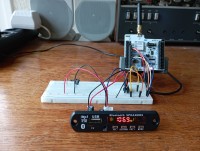Broadcast monitor using LoRaWAN and Nucleo-WL55JC1

The application is intended for a Public Broadcast Organisation, delivering regional Radio and TV programs 24/7. Radio broadcasts are aired through a transmitter and antenna installed in the open field. To guarantee the quality and continuity of the broadcasts, the reception of the programs needs to be monitored at a number of relevant locations out in the field. The idea is to install a number of small FM-receivers in the field, each connected to a NUCLEO-WL55JC1 to perform this monitoring through Lo
The sensor is in this case a small FM-receiver that is tuned to the frequency of the station to be monitored. The audio output of this receiver is rectified and passes through an RC-circuit with a sufficiently long time constant. This way we get a signal that represents the average level received.
As this small receiver uses only little energy, the 5 V power can be supplied from the NUCLEO-WL55JC1 board. That board in turn is supplied from a portable power bank so that the whole setup can be used at any location in the field without the need for a electrical power connection.
Professional Broadcast receiver
In a later phase of the project we may decide to use, at least at one of the locations, a professional broadcast receiver instead. This will provide us with a calibrated signal strength for that location.
LoRaWAN End Node
The signal from the FM-receiver is connected to the NUCLEO-WL55JC1 board. One of the ADC-channels is used to measure the signal and transmit LoRa messages.
The Things Network
An application has been defined on the TTN and an End Device connected to it.
Unfortunatedly there are no active gateways available in our area. An exploring tour through the area revealed not any message received, although transmission seems to work ok. The node, working in Class A, sends a TX request but no RX is received.
This probably means that we will have to do the same as many others, experimenting with LoRaWAN and TTN have done already: buy a commercial Gateway and install that somewhere in our aera to get a reliable transmission to TTN. This way we can at the same time, contribute to a further expansion of The Things Network.
Monitoring
Once our messages arrive at the TTN Network server we will define MQTT integration and install a small Raspberry Pi server to receive the messages and use them do display the signals in a Node-Red dashboard.
Work in progress
Although the project hasn’t been completed yet, we have built and tested most of the crictical parts. This gives us sufficient confidence to continue the project. Next step will be, finding budget to invest in a ready-to-use gateway




Diskussion (0 Kommentare)